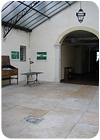
For 150 years, a classic 18th century Italian villa -- known simply as "Villa Novare" -- has been a worldwide symbol for the Bertani Winery and its renowned collection of products. And inside the winery itself, the abundant stonework has actually played a useful role in the winemaking process.
The Bertani Winery was founded in 1857 by brothers Giovanbattista and Gaetano Bertani, and the villa is located in the heart of the vineyards where Amarone and Valpolicella Classico Superiore are born. Since those early years, the winery has consistently distinguished itself on an international level with its high-quality grapes and wines, which have garnered a host of worldwide awards. In particular, its Amarone wines have been praised for their distinctive "house style" that is highly prized among both patrons and critics.
The interior of the winery is characterized by the prominent use of locally quarried stone, which was extracted from the nearby hills. Although the surface of the stone has a textured appearance, it has developed a smooth patina over the years, which adds to the comfortable elegance of the space. Large slabs of this stone were used for flooring throughout the interior, and they also form broad staircases that connect one to another and ultimately lead to the cellar, where the barrels are stored.
The stone slabs that comprise the cellar floor provide an ideal setting for the barrels to age, as they help to keep the overall humidity down. Since the wines are aged in very large, hard oak casks -- rather than the smaller barrels that most red wines see -- oak is only a small part of the integrated whole of the wine.
The wide stone stair treads have also played an important role during the process, as they allowed workers enough clearance to roll the barrels up and down the staircases as needed. Today, the fixtures for the pulleys that were used during transport can still be found on the walls at the top of each staircase and at the landings.
The outside entrance to the villa itself also features stone paving, further connecting it to the landscape. Moreover, the grounds surrounding the villa were designed as an English-style garden, creating an overall feel of tranquility. Features of the landscape include a picturesque pond with a small stone-clad structure on the shoreline.
The villa and winery remain a highlight for many travelers visiting the Veneto region of Italy, and Bertani regularly hosts tours of wine lovers from around the world. The villa itself is used for private banquets and other functions, and the production of Bertani wine continues a pattern of excellence that has spanned across the 19th, 20th and 21st centuries. In just one example of the winery's historical lore (and illustrating the value of Bertani's wines), approximately 7,000 bottles of the 1928 vintage were saved during World War II by moving them from the Bertani cellar to a farmhouse owned by the family. The bottles were stored in darkness for more than 40 years until 1984, when restoration work on the farmhouse brought the bottles back into the light. The bottles were returned to the winery, and they are still whole and drinkable. However, it was decided that the bottles would never be put on sale; rather they would be used exclusively for special occasions and tastings.